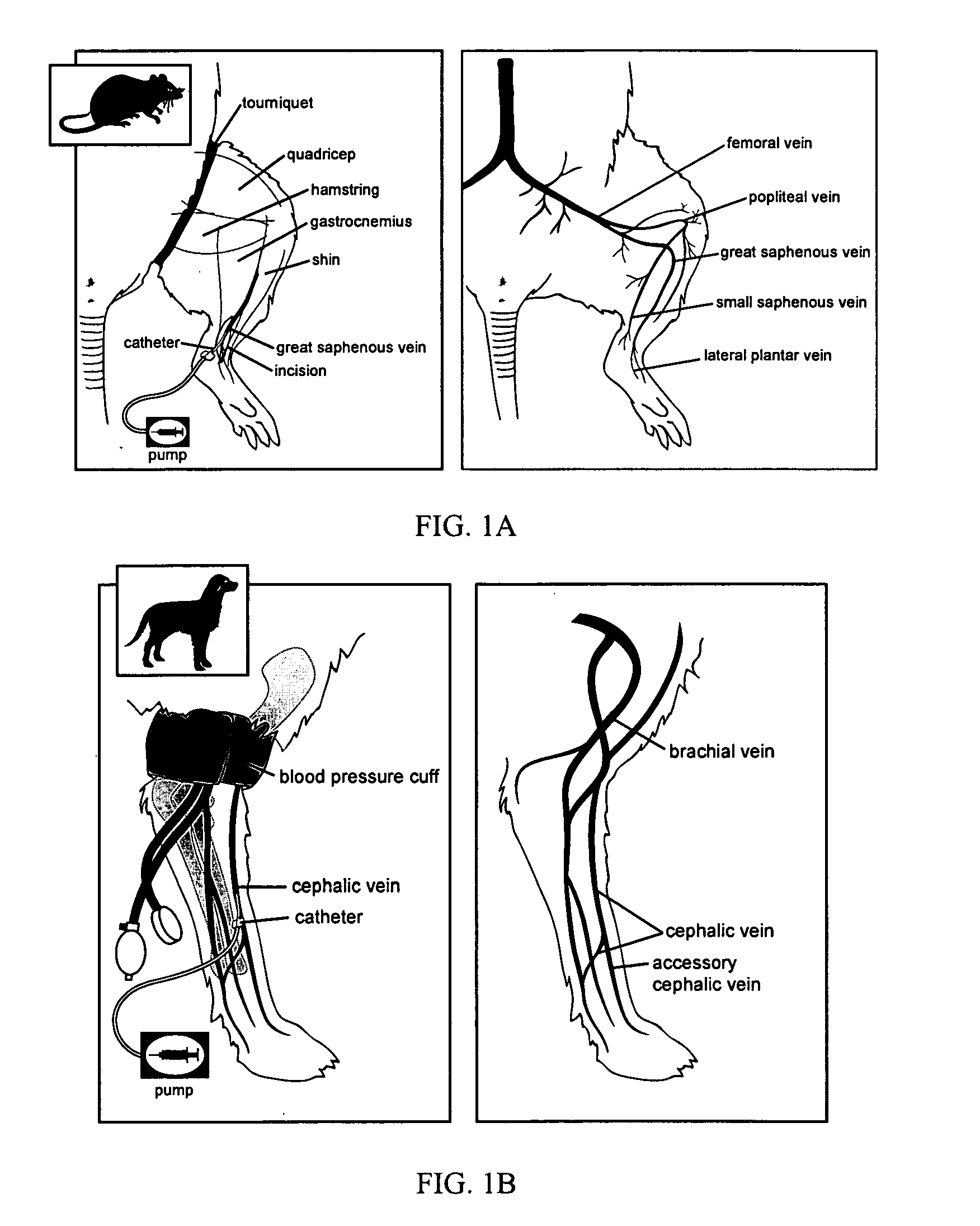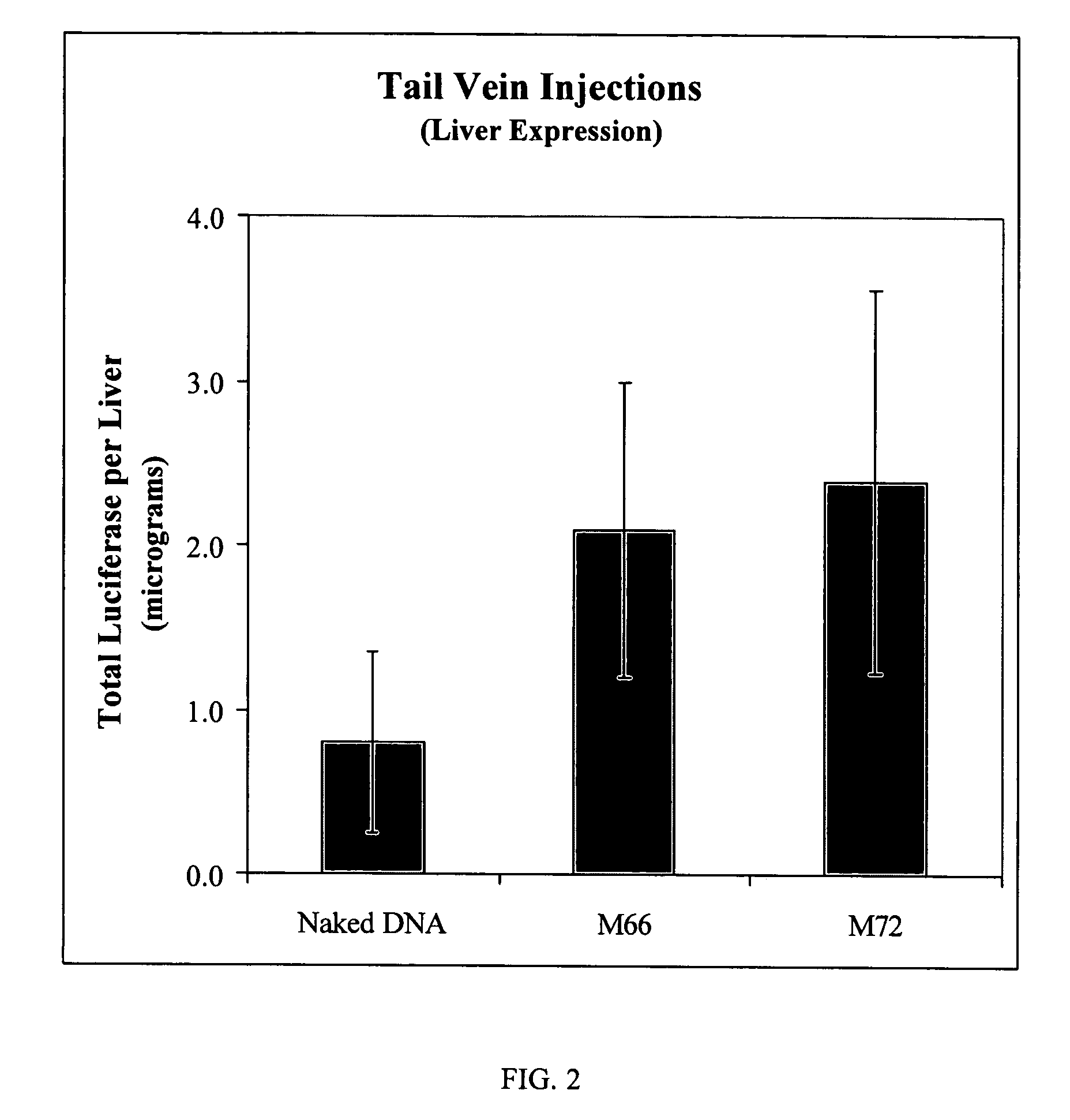Intravascular delivery of non-viral nucleic acid
a nucleic acid and intravascular technology, applied in the direction of non-active genetic ingredients, peptide/protein ingredients, genetic material ingredients, etc., can solve the problem of not being readily clinically viable, and achieve the effect of increasing the permeability of the vessel
- Summary
- Abstract
- Description
- Claims
- Application Information
AI Technical Summary
Benefits of technology
Problems solved by technology
Method used
Image
Examples
example 1
Reporter Polynucleotides
[0100] The pCI-Luc-K expression vector was generated by ligating the CMV enhancer / promoter (pCI mammalian expression vector; Promega, Madison, Wis.) to the expression cassette of the firefly luciferase reporter gene (pSP-luc+ expression vector—Promega) and replacing the ampicillin antibiotic resistance gene with the kanamycin antibiotic resistance gene. pCI-LacZ is similar to pCI-Luc-K and contained the β-galactosidase reporter gene under control of a cytomegalovirus enhancer / promoter. pCMV-hSEAP expresses human secreted alkaline phosphatase, hSEAP, from the cytomegalovirus enhancer / promoter. pMIR48 contains the firefly luciferase gene under control of the cytomegalovirus enhancer / promoter.
[0101] Reporter or marker genes, such as the genes for luciferase and β-galactosidase, serve as useful paradigms for expression of intracellular proteins in general. Similarly, reporter or marker genes, such as secreted alkaline phosphatase (SEAP) serve as useful paradigm...
example 2
Intravascular Injections of DNA / Labile Polymer Complexes
[0103] A. Synthesis of L-cystine-1,4-bis(3-aminopropyl)piperazine copolymer (M66): To a solution of L-cystine (1 g, 4.2 mmol, Aldrich Chemical Company) in acetone (10 ml) and water (10 ml) was added 2-(tert-butoxycarbonyloxyimino)-2-phenylacetonitrile (2.5 g, 10 mmol, Aldrich) and triethylamine (1.4 ml, 10 mmol, Aldrich) to yield N,N′-Bis(t-BOC)-L-cystine. The reaction was allowed to stir overnight at room temperature. The water and acetone was then removed by rotary evaporation resulting in a yellow solid. The diBOC compound was then isolated by flash chromatography on silica gel eluting with ethyl acetate 0.1% acetic acid. To a solution of N,N′-Bis(t-BOC)-L-cystine (85 mg, 0.15 mmol) in ethyl acetate (20 ml) was added N,N′-dicyclohexylcarbodiimide (108 mg, 0.5 mmol) and N-hyroxysuccinimide (60 mg, 0.5 mmol). After 2 hr, the solution was filtered through a cotton plug and 1,4-bis(3-aminopropyl)piperazine (54 μL, 0.25 mmol) wa...
example 3
[0109] A. Synthesis of 5,5′-Dithiobis(2-nitrobenzoic acid)-Tetraethylenepentamine Copolymer (M57): Tetraethylenepentamine (3.2 μL, 0.017 mmol, Aldrich) was taken up in 1.0 ml dichloromethane and HCl (1 ml, 1 M in Et2O, Aldrich) was added Et2O was added and the resulting HCl salt was collected by filtration. The salt was taken up in 1 ml DMF and 5,5′-dithiobis[succinimidyl (2-nitrobenzoate)] (10 mg, 0.017 mmol) was added. The resulting solution was heated to 80° C. and diisopropylethylamine (15 μL, 0.085 mmol, Aldrich) was added dropwise. After 16 hr, the solution was cooled, diluted with 3 ml H2O, and dialyzed in 12,000-14,000 MW cutoff tubing against water (2×2 L) for 24 h. The solution was then removed from dialysis tubing and dried by lyophilization to yield 5.8 mg (62%) of 5,5′-dithiobis(2-nitrobenzoic acid)-tetraethylenepentamine copolymer.
[0110] B. Mouse Tail Vein Injections of pDNA (pCI Luc) / M57 Polymer Complexes:
[0111] Complexes were prepared as follows: [0112] Complex I: ...
PUM
| Property | Measurement | Unit |
|---|---|---|
| pressure | aaaaa | aaaaa |
| pressure | aaaaa | aaaaa |
| weight | aaaaa | aaaaa |
Abstract
Description
Claims
Application Information
 Login to View More
Login to View More - R&D
- Intellectual Property
- Life Sciences
- Materials
- Tech Scout
- Unparalleled Data Quality
- Higher Quality Content
- 60% Fewer Hallucinations
Browse by: Latest US Patents, China's latest patents, Technical Efficacy Thesaurus, Application Domain, Technology Topic, Popular Technical Reports.
© 2025 PatSnap. All rights reserved.Legal|Privacy policy|Modern Slavery Act Transparency Statement|Sitemap|About US| Contact US: help@patsnap.com



